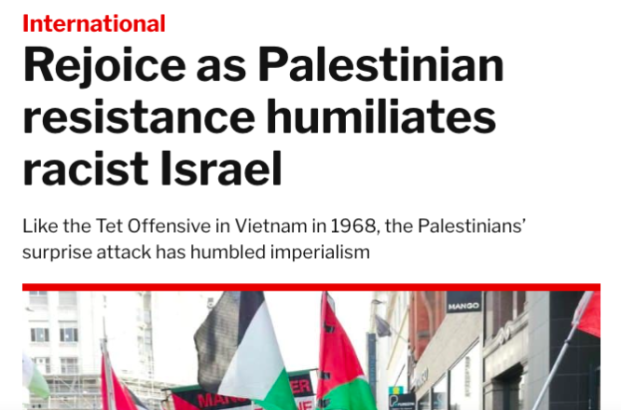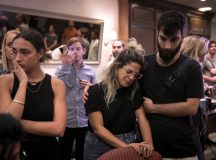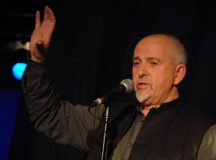Alan Johnson is the editor of Fathom. This chapter was first published in Responses to 7 October: Antisemitic Discourse, one of three volumes responding to the 7 October attack, edited by Rosa Freedman and David Hirsh with Odeliya Lanir Zafir, Routledge 2024. The book is part of Routledge’s Studies in Antisemitism Series edited by Hirsh and Freedman for the London Centre for the Study of Contemporary Antisemitism. The chapter is reprinted here with the kind permission of Routledge and the editors. To purchase books from the series visit https://www.routledge.com/Studies-in-Contemporary-Antisemitism/book-series/SICA
Introduction: Rejoice! It’s the Worst Massacre of Jews since the Holocaust
Confronted on 7 October with the worst antisemitic massacre since the Holocaust the response of parts of the radical left was politically degenerate. ‘Rejoice!’ read the front page of Alex Callinicos’ Socialist Worker. Rivkah Brown, commissioning editor at the radical left Novara Media was also jubilant: ‘Today should be a day of celebration … The struggle for freedom is rarely bloodless and we shouldn’t apologise for it’. These reactions were not uncommon. ‘They are rising up against the colonizers’ wrote a joyous Tariq Ali at the Verso Press website. Gilbert Achcar, a professor at SOAS writing in the revolutionary socialist magazine International Viewpoint, was no less admiring. ‘Gaza’s latest counter-offensive brings to mind the 1943 Warsaw Ghetto Uprising’ he wrote, equating the Jewish anti-Nazi resistance of World War Two with the Nazi-like Islamist-Jihadist rape and murder of Jewish civilians, babies included, in 2023. Tellingly, Achcar also paraded his visceral objection to ‘grieving Israelis, women in particular’ being shown on TV, foreshadowing what was soon to happen to the posters of kidnapped Israelis in cities across the west. The French Nouveau Parti Anticapitaliste declared it was ‘not joining in the litany of calls for so-called “de-escalation”’ and ‘reiterates its support for the Palestinians and the means they have chosen to resist. Intifada!’ (emphasis added). The Marxist economist Yanis Varoufakis boasted in the days after the pogrom that ‘Those who try very hard to extract from people like me a condemnation of the attacks of the Hamas guerrillas will never get it, and for a very simple reason … the criminals here are not Hamas’. And so on.[1] Susie Linfield captured the moment in her essential essay, ‘The return of the progressive atrocity’.[2]
There are several causes of this political degeneracy, including the influence of both Islamist and postmodern / identitarian ideas, but I focus here on the lesser-known role of the political tradition of ‘post-Trotsky Trotskyism’ and four bad ideas, which I label campism, unconditionality, reality-inversion and substitutionism, that have their source in that tradition, but which been flowing into the wider left through three channels.
Part 1: Four Bad Ideas
By the late 1940s Trotskyism, ostensibly the revolutionary democratic alternative to Stalinism, was close to collapse as a political movement. Leon Trotsky had been murdered in Mexico by Stalin in 1940. The Left Opposition in Russia had either capitulated to Stalin, been shot, or sent to the Gulag. The European sections were tiny, their cadre war-ravaged, and their leaderships inexperienced. More important still, the political perspectives bequeathed by Trotsky had been radically falsified by events. Far from collapsing as he predicted, Stalinism had expanded in the East. Capitalism, far from sinking further into its ‘death agony’, was in rude health, ensuring reformism consolidated its influence over the organised working class in the West. In response, in the late 1940s and early 1950s, the Trotskyists, isolated, lacking influence, and theoretically bewildered, sought ‘refuge in stark unreason … in fantasies and delusion’, argues the socialist Sean Matgamna.[3]
In place of rational socialist politics, the Trotskyists substituted a compensatory theory that depicted ‘the world revolution’ as ‘a mystical and pervasive “process” acting behind or even in spite of the material class struggle’. This revolution was seen as ‘unfolding’ in ‘waves’ and, crucially, was now using for its purposes not Marx’s conscious and organised class-for-itself but various substitute agencies: Stalinist parties and Stalinist-led peasant armies.[4] Around the time of the Korean War, noted Matgamna, the Trotskyists persuaded themselves that ‘the seemingly inevitable Third World War would be a war-revolution, an international civil war’ and that ‘the “Red” Army and its CP allies in Western Europe would bring working class victory’. This ‘crazy other-worldly, millenarian logic’ had a dire political consequence: ‘By the early 1950s, Stalinist victory in China, the war raging in Korea, and the seeming imminence of WW3, combined to make the Orthodox Trotskyists a mere tail of Russia in international affairs, a critical and cavilling tail, but a tail none the less’.[5] As Clive Bradley has put it, post-Trotsky Trotskyism ‘collapsed independent working-class politics into a crude view of international power-politics “blocs” … there is only “Imperialism” and “The Revolution” fighting it out. Socialists must choose their camp.’ [6]
So, alongside a formal obeisance to the sacred texts, ‘Trotskyism’ became defined in practice by four (dis)orientating ideas: (i) crude two-campism as a world view; (ii) unconditionality in defence of the supposedly progressive camp, defined as such, as ‘the Revolution’, when and because it was in conflict with ‘Imperialism’ whatever its own ideas or actions were; (iii) an inversion of political reality that was licensed by this absurd dogma, with the seemingly reactionary being redefined as the ‘objectively progressive’; and (iv) an increasingly bizarre substitutionism when it came to the identification of and support for ‘objectively revolutionary’ agencies. The result, Matgamna concluded, was ‘an archipelago of “Trotskyist” organisations, a large part of which is inhabited by people who are, in politics, little short of lunatics’.[7] Armed with these ideas, ‘Chris Reynolds’ (Martin Thomas) wrote, the Trotskyist sects were often willing to ‘act as attorney for some of the vilest regimes in the world’.[8]
First Substitution: Progressive Stalinism
By May 1951 Trotsky’s widow Natalia had had enough. She explained to the European leadership of the Trotskyist movement why she was resigning: ‘Obsessed by old and outlived formulas, you continue to regard the Stalinist states as a workers state … There is hardly a country in the world where the authentic ideas and bearers of socialism are so barbarously hounded … [yet] you maintain that the despotic Stalinist reaction which has triumphed in Eastern Europe is one of the roads through which socialism will eventually come’.[9] A mistaken dogma licencing a grotesque inversion of the truth, causing radicals to defend a vicious reaction as ‘objectively’ progressive? Is this not the idiocy that has so appalled us about the ‘progressive’ reactions since 7 October?
The Trotskyists’ new theory had effected a ‘destruction of all rational notion of ends and means’ in politics, observed Matgamna.[10] Like the millenarians who ‘looked to supernatural events like the second coming of Christ to transform the world into an ideal place’, the Trotskyists now cast around for increasingly absurd substitutes for the missing working class.[11] Even the best of them did this. For example, one of the more interesting Trotskyist theorists of the last 50 years has been the intellectual historian Michael Löwy. But alongside his excellent book on the theme of self-emancipation in Marx sits, very awkwardly, his awful post-Trotsky Trotskyist book about the ‘proletarian socialist revolutions’ of Tito, Mao and Ho. Löwy did not see in these Stalinist formations embryos of the new exploitative ruling class. Instead, and quite fantastically, and without so much as a passing nod to Marx’s refoundation of socialist politics upon the notion of ‘self-emancipation’, Löwy saw regimes which ‘acted as “representatives” of the proletariat’, whose ‘ideologies were proletarian’, who were indeed nothing less than ‘the political and programmatic expression of the proletariat by virtue of their adherence to the historical interests of the working class (abolition of capitalism, etc)’. (That ‘by virtue of’ is the site of the theoretical catastrophe because these new bureaucratic collectivist ruling classes smashed the bourgeoisie and the workers.) In the Communist Manifesto, had not Marx poured scorn on ‘feudal socialism’ which he mocked as a ploy of the Aristocracy who, ‘in order to rally the people to save them waves a proletarian alms bag in front of a banner’? Marx fully expected the proletariat to learn through struggle how to see, on the aristocracy’s ‘hindquarters’ the ‘old feudal coat of arms’, deserting ‘with loud and irreverent laughter’. Yet here was Löwy, theorising the Stalinist bureaucracy’s alms bag as ‘the political and programmatic expression of the proletariat’ and doing so from a position of full knowledge of the barbarities written across its ‘hindquarters’: one-party dictatorship, slave labour camps, abolition of trade unions, liberties and rights, political famines killing millions, systematic lying, organised stupidity, cultural repression and regression, all the filth that dragged the entire idea of ‘socialism’ through the mud. [12]
Maybe the nadir came when Ernest Mandel, without doubt the most important post-war theoretician of the movement, insisted that Pol Pot’s Killing Fields were a workers state to be defended against ‘Imperialism’ because – just listen to the wheels of the dogma grinding against reality here – ‘where the economy obviously does not operate any more on the basis of capitalist production and property relations and does not function any more according to the laws of motion of capitalism, a workers state has come into being, independently of the conditions under which this has occurred.’ (my emphasis) The workers do not have to be involved in the creation of a workers state, Mandel argued. After all, in post-war Eastern Europe ‘workers mobilisations were non-existent or extremely marginal.’ But what did Mandel make of the mass slaughter in his ‘workers state’? Did this not give him pause? No. ‘If Pol Pot has squeezed “extreme capitalist accumulation” of the forced collectivization of the Kampuchean peasantry, well, didn’t Stalin do likewise with the forced collectivisation of the Russian peasants, which was an otherwise large and bloody affair?’ [13]
Second Substitution: Anyone Shooting At The West
Matgamna has identified an all-determining shift in the political character of the campism of post-Trotsky Trotskyism. ‘The tight millenarianist scenario of 1951-53 centred on Stalinism and war as the agency eventually gave way to a looser millenarianism,’ he argued, ‘promiscuous in its ever-changing choice of saviours, prominent among them being various nationalist forces framed via ‘scholastic constructions’ as the new blunt instrument of the unfolding world revolution.[14] By the 1957 World Congress, however, the four bad ideas were being applied not only to the ‘workers’ states’ but to a nebulous notion of an ‘anti-imperialism’ now seen as the epicentre of the unfolding ‘World Revolution’.[15] By 1969 it was ‘Guerillarism’ and then, briefly, preposterously, ‘Red Bases’ in the Western universities. The substitutions have only grown more absurd and more reactionary since then, from Iranian Mullahs and Argentinian Military Dictators to Fascistic Islamists and, as we have seen since 7 October, antisemitic Jihadists who tie Jewish mothers and children together with wire and burn them alive.
The Iranian Islamic Revolution was the site of much political debauchery from the mid-1980s. The American Trotskyists explained their support for the eliminationist antisemites running the Islamist dictatorship in Tehran during the Iran-Iraq war in language we have often heard since 7 October. ‘We view this war – and all wars today from the standpoint of the international struggle against imperialism and the struggle to advance the world socialist revolution.’ To combine this kind of crude campism with the texts of the Old Man dictated a bizarre inversion of reality: ‘[The Iranian revolution] strengthened the world working class … An Iranian victory would be an inspiration for all those fighting imperialist oppression in the Mideast’.[16]
Similarly in recent decades, the SWP’s Alex Callinicos has theorised a grand reduction of the complexity of the post-cold war world to a single Great Contest: ‘Imperialism’ against ‘The Resistance.’ [17] In his political calculus Political Islamism vanishes, only to reappear, cleaned up, as ‘the anti-imperialist resistance’. But those who define Political Islamism as ‘the resistance’ must redefine themselves as critical supporters of Political Islamism. And so Callinicos did. ‘The Mullahs defeat’ he announced, preposterously, in 1988, ‘is a defeat for the world working class’.[18] Later, after 2003, when Saddam loyalists tied up Hadi Saleh, an Iraqi trade union leader, to a radiator, tortured and shot him, Callinicos dismissed the outrage about this as ‘a hullaballoo about a collaborator’. He had turned himself into an exponent of the same Manichean world-view and habits of mind that dominated so much of the left in the Stalinist period – from apologia to denial, from cynicism to grossly simplifying tendencies of thought, from the belief that ‘my enemy’s enemy is my friend’ to the abandonment of all those – democrats, trade unionists, women, Jews and others – who get on the wrong side of the ludicrously valorised ‘resistance’.
Part 2: Three Channels of Influence
The four bad ideas of post-Trotsky Trotskyism have been seeping into the wider left for decades. Their influence has flowed along three main channels, each associated with leaders of the post-war movement: Ernest Mandel, Gerry Healy and Tony Cliff.
Iron Dictatorships: From Ernest Mandel to New Left Review
Since the 1960s, no journal has been more influential on the western left than New Left Review. And from the late 1960s to at least the mid 1980s, no influence was greater upon NLR than post-Trotsky Trotskyism. Editorial board members Robin Blackburn, Norman Geras, and Quintin Hoare were Trotskyist militants in the Unified Secretariat of the Fourth International led by Ernest Mandel, as were Tariq Ali, Henri Weber and other regular contributors. Perry Anderson, the editor and directing influence of ‘the Western Left’s flagship journal’, was especially close to Mandelism for a period.
For twenty years Mandel defined Mao’s monstrous regime as a ‘workers state’ with no qualifications, arguing that ‘the Chinese Communist Party … was striving to destroy capitalism and therefore represented a fundamentally proletarian social force’. [19] (Those two words ‘and therefore’ are the ground zero of the entire theoretical catastrophe of post-Trotsky Trotskyism.) Perry Anderson followed Mandel’s lead, arguing that ‘The iron dictatorship exercised by the Stalinist police administrative apparatus over the Soviet proletariat was not incompatible with the preservation of the proletarian nature of the state itself – any more than the … fascist dictatorships exercised over the bourgeois class were the preservation of the nature of the capitalist state.’[20] The workers may well be literally slaves, Mandel and Anderson agreed, but the state is still, mystically, ‘theirs’ as long as the state has nationalised property; still, mystically, an expression of the ‘World Revolution; and still, therefore, to be defended unconditionally against ‘Imperialism’ by the western left.
Thug Life: From Gerry Healy to the London Left
The second channel of influence, particularly important in the UK, has run from Gerry Healy’s thuggish, antisemitic and Arab-dictator-funded Workers Revolutionary Party through parts of the London Labour Left in the 1970s and 1980s, and then to strands of Corbynism in the 2010s and 2020s. The Labour radical left does not have a body of knowledge of its own, let alone a theory, and so gets its ideas from a blend of the British Trotskyist and Communist traditions more often than is appreciated.
In the late 1970s, Matgamna writes, ‘Healy sold the [WRP] to Libya, Iraq and some of the Arab sheikdoms as a propaganda outlet and a jobbing agency for spying on Arab dissidents and prominent Jews (“Zionists”) in Britain. (I myself saw them finger Arab dissidents in Manchester at a protest so that Embassy thugs could beat them up.) Arab gold paid for a daily colour newspaper, Newsline, that ‘churned out crude Arab-chauvinist propaganda lauding Saddam Hussein and Libya’s ruler Colonel Gaddafi and denouncing Israel and “Zionism”’ as well as a property empire of bookshops and ‘training centres’. [21]
Lambeth Labour leader Ted Knight, a Healyite organiser in the 1950s, was thought by many to be still a Healy operative. ‘Red’ Ken Livingstone, one-time Mayor of London, was absolutely central to Labour left politics in the 1980s. He learnt his nonsense about Zionism and Nazism from ex-Trotskyist Lenni Brenner.[22] And he was also a big fan of Healy, writing a fawning foreword to a hagiography of the rapist thug (’not such a scary monster’ he quipped).[23] Through the WRP-printed newspaper Labour Herald, ‘a Labour left paper nominally edited by Ken Livingstone and Ted Knight but actually run by the WRP’ claims Matgamna, Healy seeded the London left with the very antisemitic forms of ‘anti-Zionism’ (including antisemitic cartoons) that disgraced the UK Labour Party after 2015.[24]
‘Even Stranger Forces’: From Tony Cliff to Stop the War
The third channel of influence, and the most important, has run from Tony Cliff’s Socialist Workers Party to ‘Stop the War’. Tony Cliff’s absolute ‘anti-Zionism’ and Alex Callinicos’s crude campism were given mass, activist, culture-changing form with the creation of ‘Stop the War’ by the Cliffites John Rees, Lindsey German and Chris Nineham. [25] Once known for its Third Camp slogan ‘Neither Washington nor Moscow’ the SWP lurched wildly to embrace a particularly crude and absolutist version of two-campism from the mid 1980s, siding with the Mullahs in the Iran-Iraq war and the Serb assault on Kosovo, then refusing to condemn the terrorism of Al Qaeda on 9/11, before siding with the fascistic ‘resistance’ in Iraq, even against Iraq’s free trade union movement.[26] Matgamna drew out the political meaning: ‘the SWP had let itself be magnetised by Islamic clerical fascism, and taken up something like the quasi apologetics the worst Orthodox Trotskyists sometimes took up in relation to Stalinism’.[27]
Alex Callinicos did the standard work of post-Trotsky Trotskyist theoreticians: the tortuous reconciliation of the texts of classical Marxism with the four bad ideas. He explained that what Lenin had once said about the necessity of socialists supporting popular struggles for national liberation was applicable in our era to socialists supporting any old vicious sub-imperialism, theocratic fascism or antisemitic Islamist terror gang shooting at the West and its allies. ‘The experience of the last 30 years’, he wrote ‘has amply confirmed Lenin’s analysis. The Vietnam war … stimulated the growth of authentically anti-capitalist movements throughout the western world. Since then, even stranger forces than Vietnamese Stalinism have become the focus of confrontations with imperialism – the fundamentalist mullahs of Iran and of Lebanon and even the Iraqi Ba’athist regime … in such confrontations revolutionary socialists hope for the defeat of the imperialist power’.[28] John Rees, then a leader of the SWP, later a founder of Stop the War, theorised left-wing support for fascistic reaction: ‘Socialists should unconditionally stand with the oppressed against the oppressor, even if the people who run the oppressed country are undemocratic and persecute minorities’. [29] Note how each of the four bad ideas – campism, unconditionality, reality-inversion and substitutionism – is expressed paradigmatically in those 24 words. Another SWP theoretician, the late John Molyneux, like Löwy an author of some fine studies of the old texts of classical Marxism, could also, like Löwy, express cheek by jowl the crass spirit of post-Trotsky Trotskyist theory: ‘It is not a question of the rights and wrongs of the situation’ he wrote, but rather ‘It is a question of understanding the imperialist character of the western powers’ (1992: 9). And Molyneux drew out the logic of this world view for the Israel-Palestine conflict with especial clarity: ‘We on the left should not, I suggest, “condemn” Palestinian suicide bombers’.[30]
Conclusion
These ‘old and outlived formulas’ of post-Trotsky Trotskyism have been exercising an underappreciated influence on the wider left for a long time. Judith Butler, perhaps the most globally influential left academic cultural theorist, tells her students that ‘Understanding Hamas and Hezbollah as social movements that are progressive, that are on the left, that are part of a global left, is extremely important.’ Jeremy Corbyn, one-time leader of the Labour Party, no less, spent four years educating the UK left that Hamas and Hezbollah are our ‘friends’, political forces ‘dedicated towards the good of the Palestinian people and bringing about long-term peace and social justice and political justice in the whole region’. The ostensibly ‘left-wing’ marchers who paraded some years ago through European cities waving placards declaring ‘We Are All Hezbollah!’ expressed all four bad ideas in just four words. Since 7 October we have watched marchers wave banners depicting a Star of David being drowned in the Mediterranean sea (without one steward or marcher objecting). We have even seen American students at Pamona College create a shrine, complete with teddy bears, for the Hamas ‘insurgents who have died’ [31]
So while the song may remain the same, a lot more people are singing it today. Just as in an earlier era, when the Trotskyists said palpably barbaric anti-working class tyrannies were really ‘workers states’ to be defended unconditionally against ‘Imperialism’; just as when a wider revolutionary new left said vicious reactionary sub-imperialist predators had really been ‘anti-imperialists’ to be cheered on to victory; so today an even broader ‘left’ is responding to the worst antisemitic pogrom since the Holocaust with calls for two, three, many 7 Octobers which they fantasise will be a global ‘intifada-revolution’.
It is clear there is now a critical mass of emboldened western pogromists-in-waiting, largely concentrated in the Islamist movements and parts of the communities that sustain those movements. It is also clear that some well-funded, organised and increasingly influential parts of the global left are fully signed up to the role of pogrom-apologists-in-waiting. I think they have been readied for this role in no small part by the malign and spreading influence of the cluster of bad ideas derived from post-Trotsky Trotskyism that have been discussed in this essay: that the world is made up of two-camps, that the left’s role is to unconditionally defend whoever is shooting at the Imperialist camp, that that shooting turns the apparently reactionary into the objectively progressive, and that ever ‘stranger forces’ can substitute for the missing socialist and democratic working class movement. The political lunatics are on the march.
[1] Johnson, A. (2023) ‘“Progressives” and the Hamas Pogrom: An A-Z Guide’, Fathom, October.
[2] Linfield, S. (2023) The Return of the Progressive Atrocity’, Quillette, 18 November. https://quillette.com/2023/11/18/the-return-of-the-progressive-atrocity/
[3] Matgamna, S (1992) Trotskyism after the collapse of Stalinism: An open letter to Ernest Mandel, London, Alliance for Workers Liberty, p 1. Sean Matgamna has been one of the most articulate left-wing critics of not only ‘post-Trotsky Trotskyism’ but also left antisemitism since the 1980s, framing the latter as first and foremost the denial, extended to no other state by the left, of Israel’s right to exist and, as a result, a comprehensive and unique hostility to pro-Israel Jews, that is to most Jews alive, branding them as ‘Zionists’ and seeing that description as akin to ‘racism’ or ‘imperialism’. He was known affectionately as ‘Rebbe Matgamna’ to the Union of Jewish Students activists who allied with Matgamna’s group, Socialist Organiser, in the mid-1980s to successfully block the drive by the far left to ban Jewish student societies. I believe no one has done more to rally a generation of left-wingers, including the author of this chapter, to understand and oppose left antisemitism, and with no small consequences for recent British politics. And few deserve a wider readership. See, especially, Matgamna, S. (2017) The left in disarray, London, Workers Liberty Press; Matgamna, S. (2015) The Two Trotskyisms Confront Stalinism: Debates, essays and confrontations (Second Edition), London, Workers Liberty Press; Matgamna, S. (ed.) (2019) Arabs, Jews and Socialism: The socialist debate in the 80s and 90s on Israel and Palestine and the development of Workers’ Liberty’s ideas, London, Workers Liberty. https://www.workersliberty.org/story/2019-06-20/arabs-jews-and-socialism-note-2019-introduction-2019-preface-1989; Matgamna, S (2023) ‘What is Left Antisemitism?’, in Johnson, A (ed.) Mapping the New Left Antisemitism: The Fathom Essays, London, Routledge.
[4] International-Communist League (1976) ‘I-CL fusion resolution on the Fourth International’ [December 1975], in The I-CL and the Fourth International, (International Communist Special No.1, London, International Communist League, p.7.
[5] Matgamna, S. (2017) The left in disarray, London, Workers Press, p. 359, 372.
[6] Bradley, C. (1985) ‘The USFI Today’, in Under Whose Flag. Trotskyists Today: working class socialism or Third World Nationalism, London, Socialist Organiser Alliance, p. 33.
[7] Matgamna, S (1992) Trotskyism after the collapse of Stalinism: An open letter to Ernest Mandel, London, Alliance for Workers Liberty, p. 2.
[8] ‘Reynolds, C.’ [Thomas, M.] ‘Class Politics or Bloc Politics?’ in Under Whose Flag. Trotskyists Today: working class socialism or Third World Nationalism, London, Socialist Organiser Alliance, p. 7.
[9] Natalia T. (1972) ‘Natalia Trotsky’s Document’, in Higgins J. (ed.) Natalia Trotsky and the Fourth International, London, Pluto Press, pp. 9-11.
[10] Matgamna, S. (2017) The left in disarray, London, Workers Liberty Press, p. 358.
[11] Ibid. p. 359.
[12] Löwy, M. (1981) The Politics of Combined and Uneven Development: The Theory of Permanent Revolution, London, Verso.
[13] Goodwin, P. (1979) ‘“Razor sharp factional minds” – the Fourth International debates Kampuchea’, International Socialism, 2:5, 106-114. https://www.marxists.org/history/etol/newspape/isj2/1979/isj2-005/goodwin.html
[14] Matgamna, S. (2017) ‘The left in disarray, London, Workers Liberty Press, p. 360.
[15] Matgamna, S. (2017) ‘What is reactionary anti-imperialism?’ in The left in disarray, London, Workers Liberty Press, pp. 279-284.
[16] Quoted in Bradley, C. (1985) ‘The USFI Today’, in Under Whose Flag. Trotskyists Today: working class socialism or Third World Nationalism, London, Socialist Organiser Alliance, p. 33.
[17] Callinicos, A. (1994) ‘Imperialism today’, in Marxism and the New Imperialism, Alex Callinicos et a; (eds.) London, Bookmarks, pp. 11-66. See also XXXX
[18] Callinicos, A. (1988) ‘An Imperialist Peace?’, Socialist Worker Review, September, p. 20.
[19] Mandel, E. (1979) Revolutionary Marxism Today, London, Verso, p. 158.
[20] Anderson, P. (1983) ‘Trotsky’s Interpretation of Stalinism’, New Left Review, 1/139, p. 52.
[21] Matgamna, S. (2017) The left in disarray, London, Workers Liberty Press, p. 377.
[22] See Ben-Noah, G. (1984) ‘Brenner on the Nazi massacre’, Socialist Organiser, 4 October. https://www.workersliberty.org/files/brennerreview.pdf and Bogdanor, P. (2023) ‘Holocaust Falsifiers. Blaming “Zionists” for the Crimes of the Nazis’, in Johnson A. (ed.) Mapping the New left Antisemitism: The Fathom Essays, London, Routledge, pp. 148-164.
[23] Livingstone, K (1994) foreword to Lotz, C. and Feldman P., Gerry Healy, A Revolutionary Life, London, Lupus Books. See also Cowan, C. (2019) My Search for Revolution – and how we brought down an abusive leader, Market Harborough, Troubador.
[24] See Matgamna, S. (2018) Fighting Left Antisemitism in the 1980s, Workers Liberty, 3:62. (For an example of the antisemitic cartoons published by Labour Herald see p. 5.) https://www.workersliberty.org/files/wl62-leftantisemitism.pdf The antisemitism of Labour Herald and the WRP was also discussed by Steve Cohen in his classic That’s Funny, you don’t look antisemitic. An anti-racist analysis of left antisemitism, Leeds, Beyond the Pale Collective, 42-51.
[25] See Nelson, S. (2004). ‘What’s Wrong with “Stop the War”?’, Solidarity, 21 October. https://www.workersliberty.org/story/2017-07-26/whats-wrong-stop-war
[26] Ibid. p. 345.
[27] Ibid. p. 352. See also Moffat, L. (2005) ‘“Cover Your Heads,” SWP tells protest women’, Workers Liberty. https://www.workersliberty.org/story/2017-07-26/cover-your-heads-swp-tells-protest-women
[28] Callinicos, A. (1994) ‘Imperialism today’, in Marxism and the New Imperialism, Alex Callinicos et al; (eds.) London, Bookmarks, p. 63.
[29] Rees, J. (1994) The ABC of socialism, London, Bookmarks, p. 55.
[30] Molyneux, J. (2004) ‘Marxism and Terrorism’, Socialist Worker, 6 April (First published in Socialist Review in 1984). https://socialistworker.co.uk/socialist-review-archive/marxism-terrorism/
[31] See Ginsberg Simon, E. (2023) ‘SJP’s Perfidious Presence’, Life Derailed, 25 October. https://ellenginsbergsimon.substack.com/p/sjps-perfidious-presence





































